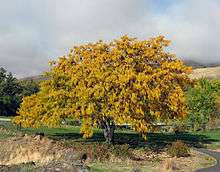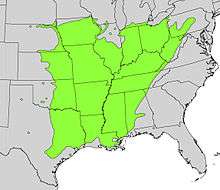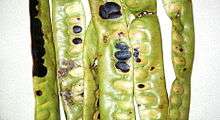Honey locust
The honey locust (Gleditsia triacanthos), also known as the thorny locust or thorny honeylocust, is a deciduous tree in the family Fabaceae, native to central North America where it is mostly found in the moist soil of river valleys.[2] Honey locust is highly adaptable to different environments, has been introduced worldwide, and is an aggressive invasive species.[2]
| Honey locust Gleditsia triacanthos | |
|---|---|
 | |
| A honey locust in Washington state shows its fall color | |
| Scientific classification | |
| Kingdom: | |
| (unranked): | |
| (unranked): | |
| (unranked): | |
| Order: | |
| Family: | |
| Genus: | |
| Species: | G. triacanthos |
| Binomial name | |
| Gleditsia triacanthos | |
 | |
| Natural range | |
Description
The honey locust, Gleditsia triacanthos, can reach a height of 20m (66 ft.). They exhibit fast growth, but live a medium-long life span of about 120 years.[3] The leaves are pinnately compound on older trees but bipinnately compound on vigorous young trees.[2] The leaflets are 1.5–2.5 cm (5⁄8–1 in) (smaller on bipinnate leaves) and bright green. They turn yellow in the autumn. Honey locusts leaf out relatively late in spring, but generally slightly earlier than the black locust (Robinia pseudoacacia). The strongly scented cream-colored flowers appear in late spring, in clusters emerging from the base of the leaf axils.
The fruit of the honey locust is a flat legume (pod) that matures in early autumn.[2] The pods are generally between 15–20 cm (6–8 in). The seeds are dispersed by grazing herbivores such as cattle and horses, which eat the pod pulp and excrete the seeds in droppings; the animal's digestive system assists in breaking down the hard seed coat, making germination easier. In addition, the seeds are released in the host's manure, providing fertilizer for them. Honey locust seed pods ripen in late spring and germinate rapidly when temperatures are warm enough.
Honey locusts commonly have thorns 3–10 cm (1 1⁄4–4 in) long growing out of the branches, some reaching lengths over 20 cm (8 in); these may be single, or branched into several points, and commonly form dense clusters.[2] The thorns are fairly soft and green when young, harden and turn red as they age, then fade to ash grey and turn brittle when mature. These thorns are thought to have evolved to protect the trees from browsing Pleistocene megafauna, which may also have been involved in seed dispersal, but the size and spacing of them is less useful in defending against smaller extant herbivores such as deer. Thornless forms (Gleditsia triacanthos var. inermis) are occasionally found growing wild and are available as nursery plants.[2] Hybridization of honey locust with water locust (G. aquatica) has been reported.[4]
Cultivation and history
Its cultivars are popular ornamental plants, especially in the northern plains of North America where few other trees can survive and prosper. It tolerates urban conditions, compacted soil, road salt, alkaline soil, heat, and drought. The popularity is in part due to the fact that it transplants so easily. The fast growth rate and tolerance of poor site conditions make it valued in areas where shade is wanted quickly, such as new parks or housing developments, and in disturbed and reclaimed environments, such as mine tailings. It is resistant to gypsy moths but is defoliated by another pest, the mimosa webworm. Spider mites, cankers, and galls are a problem with some trees. Many cultivated varieties do not have thorns.
Agriculture
The species is a major invasive environmental and economic weed in agricultural regions of Australia. The plant forms thickets and destroys the pasture required for livestock to survive. The thickets choke waterways and prevent both domestic and native animals from drinking and also harbour vermin. The spines cause damage to both people and domestic and native wildlife and puncture vehicle tires.[5][6] In much of the Midwest of the United States the honey locust is also considered a weed tree and a pest that establishes itself in farm fields.[7] In other regions of the world, ranchers and farmers who employ monocropping deem honey locust a nuisance weed; its fast growth allows it to out-compete grasses and other crops.
Uses
Food

The pulp on the inside of the pods is edible[8] (unlike the black locust, which is toxic)[9] and consumed by wildlife and livestock.[8]
Despite its name, the honey locust is not a significant honey plant.[2] The name derives from the sweet taste of the legume pulp, which was used for food and traditional medicine by Native American people, and can also be used to make tea.[2] The long pods, which eventually dry and ripen to brown or maroon, are surrounded in a tough, leathery skin that adheres strongly to the pulp within. The pulp—bright green in unripe pods—is strongly sweet, crisp and succulent in ripe pods. Dark brown tannin-rich beans are found in slots within the pulp.
Timber
Honey locusts produce a high quality, durable wood that polishes well, but the tree does not grow in sufficient numbers to support a bulk industry. However, a niche market exists for honey locust furniture. It is also used for posts and rails because of the dense, rot-resistant nature of the wood. In the past, the hard thorns of the younger trees were used as nails and the wood itself was used to fashion treenails for shipbuilding.
Nitrogen fixation
The ability of Gleditsia to fix nitrogen is disputed. Many scientific sources[10][11][12] state that Gleditsia does not fix nitrogen. Some support this statement with the fact that Gleditsia does not form root nodules with symbiotic bacteria, the assumption being that without nodulation, no nitrogen fixation can occur. In contrast, many popular sources, permaculture publications in particular, claim that Gleditsia does fix nitrogen but by some other mechanism.
There are anatomical, ecological, and taxonomic indications of nitrogen fixation in non-nodulating legumes.[13] Both nodulating and non-nodulating species have been observed to grow well in nitrogen-poor soil with non-nodulating legumes even dominating some sites. The litter and seeds of non-nodulating species contains higher nitrogen than non-legumes and sometimes even higher than nodulating legumes growing on the same site.[14] How this happens is not yet well understood but there has been some observations of nitrogenase activity in non-nodulating leguminous plants, including honey locust.[13] Electron microscopy indicates the presence of clusters around the inner cortex of roots, just outside the xylem, that resemble colonies of rhizobial bacterioids.[13] These may well constitute the evolutionary precursors in legumes for nitrogen fixation through nodulation. It is not known whether the non-nodulating nitrogen fixation, if it exists, does benefit neighboring plants as is said to be the case with nodulating legumes.
Research
In research using databases, more than 60 phytochemicals were identified from honey locust, including polyphenols, triterpenes, sterols, and saponins, with in vitro studies assessing for possible biological activity.[15]
References
- Stritch, L. (2018). "Gleditsia triacanthos". IUCN Red List of Threatened Species. 2018: e.T62026061A62026063. doi:10.2305/IUCN.UK.2018-2.RLTS.T62026061A62026063.en. Retrieved 3 May 2020.
- "Gleditsia triacanthos (honey locust)". CABI. 22 November 2017. Retrieved 9 September 2018.
- Nesom, Guy (Obtained Apr 2020). "Honey Locust" (PDF). USDA.gov Plant Guide. Check date values in:
|date=(help) - Sullivan J. (1994). "Gleditsia triacanthos". U.S. Forest Service. U.S. Department of Agriculture, Forest Service, Rocky Mountain Research Station, Fire Sciences Laboratory. Retrieved August 13, 2014.
- "Gleditsia triacanthos". Weeds in Australia. Australian Government. Retrieved January 23, 2017.
- "Gleditsia triacanthos". weeds.org. Archived from the original on 2016-03-04.
- Barlow C. (2001). "Anachronistic fruits and the ghosts who haunt them" (PDF). Arnoldia. 61 (2): 14–21.
- Little, Elbert L. (1994) [1980]. The Audubon Society Field Guide to North American Trees: Western Region (Chanticleer Press ed.). Knopf. p. 495. ISBN 0394507614.
- "Toxicity of Black Locust". www.woodweb.com. Retrieved 5 July 2016.
- Burton JC. "Nodulation and symbiotic nitrogen fixation by prairie legumes" (PDF). In Zimmerman JH. (ed.). Proceedings, 2nd Midwest Prairie Conference.
- Allen ON, Allen EK (1981). The Leguminosae: A Source Book of Characteristics, Uses, and Nodulation. Madison, WI: The University of Wisconsin Press. p. 812. ISBN 978-0-299-08400-4.
- Djumaeva D, Lamers JP, Martius C, Khamzina A, Ibragimov N, Vlek PL (2010). "Quantification of symbiotic nitrogen fixation by Elaeagnus angustifolia L. on salt-affected irrigated croplands using two 15N isotopic methods". Nutrient Cycling in Agroecosystems. 88 (3): 329–339. doi:10.1007/s10705-010-9357-5.
- Bryan JA, Berlyn GP, Gordo JC (1996). "Toward a new concept of the evolution of symbiotic nitrogen fixation in the Leguminosae". Plant and Soil. 186 (1): 151–159. doi:10.1007/BF00035069.
- Bryan J. (1995). Leguminous trees with edible beans, with indications of a rhizobial symbiosis in non-nodulating legumes (Ph.D.). Yale University. Docket UMI95-41400.
- Zhang, J. P.; Tian, X. H.; Yang, Y. X.; Liu, Q. X.; Wang, Q; Chen, L. P.; Li, H. L.; Zhang, W. D. (2016). "Gleditsia species: An ethnomedical, phytochemical and pharmacological review". Journal of Ethnopharmacology. 178: 155–71. doi:10.1016/j.jep.2015.11.044. PMID 26643065.
Further reading
- Sternberg G, Wilson J (2004). Native Trees for North American Landscapes. Portland, OR: Timber Press, Inc. p. 552. ISBN 978-0-881-92607-1.
- Little EL. (1980). The Audubon Society Field Guide To North American Trees—Western Region. New York, NY: Alfred A. Knopf. p. 640. ISBN 978-0-394-50761-3.
- Philips R. (1979). Trees of North America and Europe. New York, NY: Random House, Inc. pp. 224. ISBN 978-0-394-50259-5.
- Blair, RM. (1990). "Gleditsia triacanthos". In Burns, Russell M.; Honkala, Barbara H. (eds.). Hardwoods. Silvics of North America. Washington, D.C.: United States Forest Service (USFS), United States Department of Agriculture (USDA). 2 – via Southern Research Station (www.srs.fs.fed.us).
- Sullivan, J. (1994). "Gleditsia triacanthos". Fire Effects Information System (FEIS). US Department of Agriculture (USDA), Forest Service (USFS), Rocky Mountain Research Station, Fire Sciences Laboratory – via https://www.feis-crs.org/feis/.
External links
| Wikimedia Commons has media related to Honey locust. |
